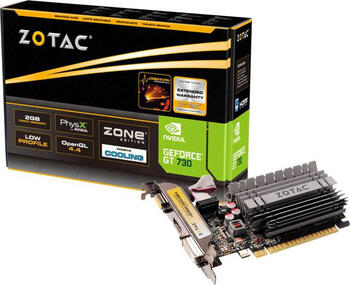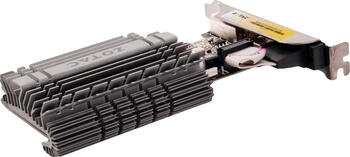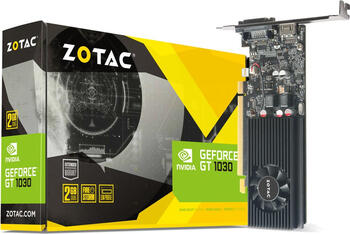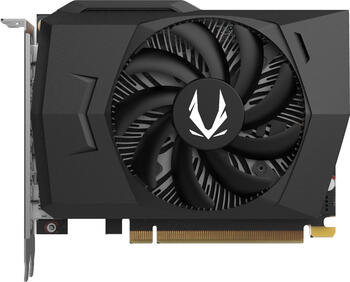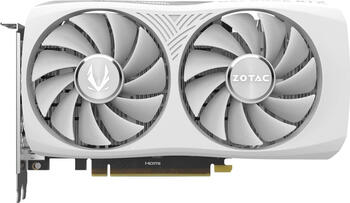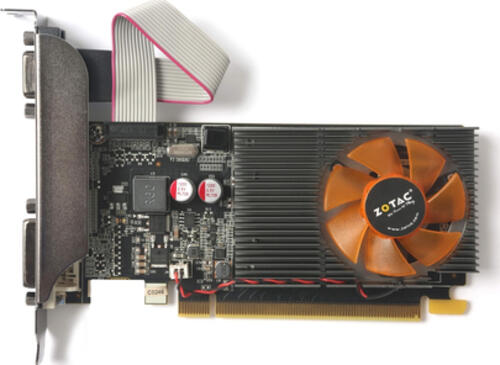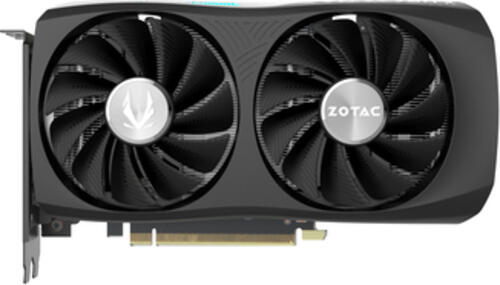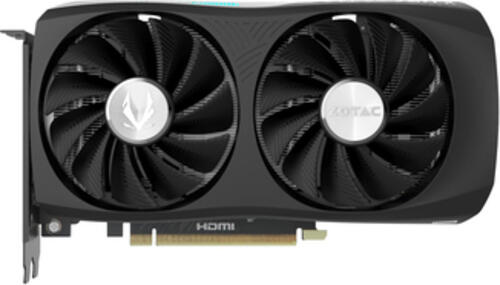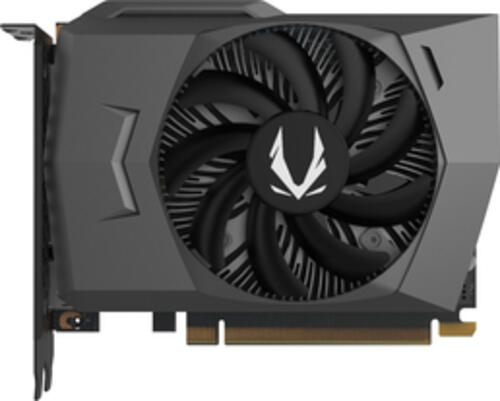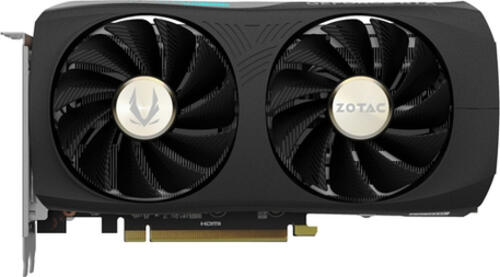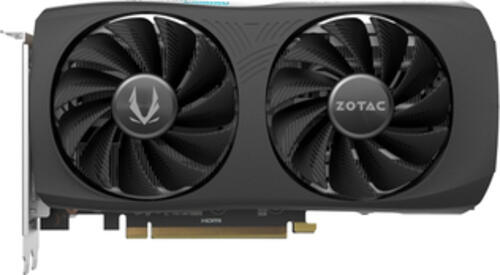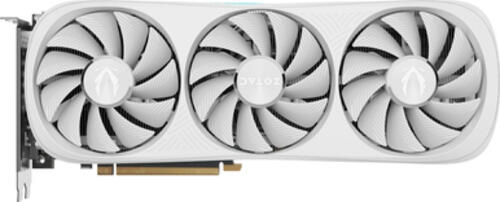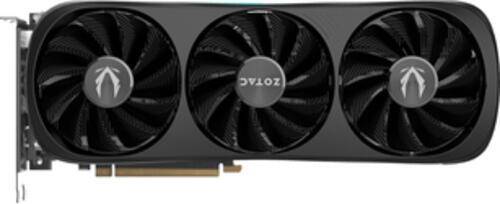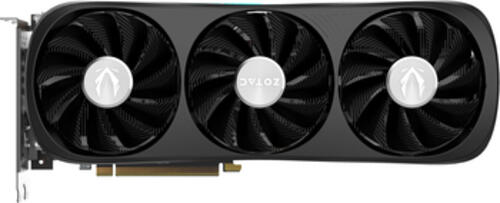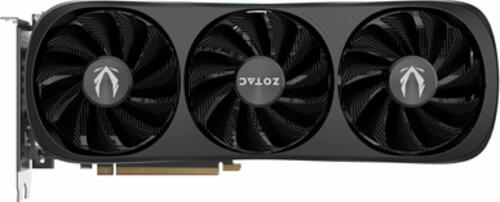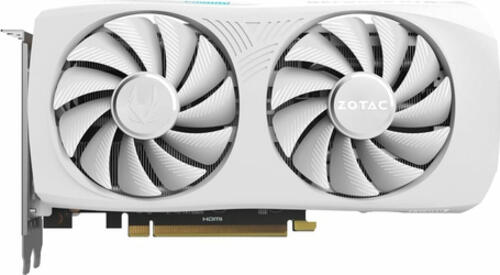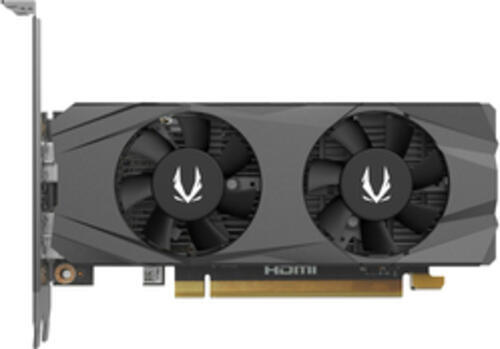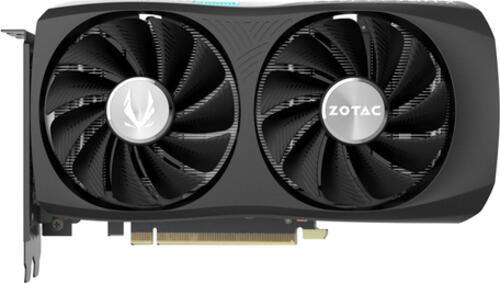Zotac GeForce GT 730 (GK208) passiv, 2GB DDR3 , Grafikkarte VGA, DVI, HDMI 1.4
Artikelnr. A0641556 Herstellernr. ZT-71113-20L
84,42 €
- Modell: NVIDIA GeForce GT 730
- Speicher: 2GB DDR3, 64bit, 1.6Gbps, 800MHz, 13GB/s
- Takt Basis: 902MHz
- Takt Boost: unbekannt
- Übertaktung: -
- Kühlung: Passivkühlung
- TDP/TGP: 38W (NVIDIA)
- Stromanschlüsse: -
- Anschlüsse: 1x VGA, 1x DVI, 1x HDMI 1.4a
- Anbindung: PCIe 2.0 x16 (x8)
- Mini-ITX-Format (&8804;185mm)
- Gesamthöhe: Dual Slot
- Bauform: PCIe-Karte (low profile)
- Slotblende: full height + low profile (Lieferumfang)
- Chip-Daten:
- Chip-Architektur: Kepler 2.0 (ab 2013/Q2)
- Chip-Bezeichnung: GK208-302-B1
- Chip-Konfiguration: 2SMX (384SP / 32TMU / 8ROP), 128kB L2-Cache
- Chip-Fertigung: TSMC 28nm
- Chip-Größe: 87mm, monolithisch, 915 Mio. Transistoren
- API-Unterstützung: DirectX 12 (11_0) / CUDA 3.5 / Vulkan 1.3 / OpenCL 3.0 / OpenGL 4.6 / Shader Model 5.1
- Transcoding-Engine: Info
- Encoding: -
- Decoding: -
- Multi-GPU-Anbindung: -
- Vorstellung (Serie): 18.06.2014
- Grafik: NVIDIA GeForce GT 730 - 2GB DDR3 - Desktop
weitere Informationen
Im Versandlager
Abholung/ Versand möglich am Montag, den 18.11
Zotac GeForce GT 730 passiv, 800MHz, 4GB DDR3 Grafikkarte, VGA, DVI, HDMI
Artikelnr. A0641647 Herstellernr. ZT-71115-20L
92,34 €
- Anschlüsse: 1x VGA, 1x DVI, 1x HDMI 1.4
- Grafik: NVIDIA GeForce GT 730 - 4GB DDR3 - Desktop
- Chip: GK208B Kepler 2.0, 2SMX, 87mm
- Fertigung: 28nm (TSMC)
- Speicher: 4GB DDR3, 800MHz, 1.6Gbps (1600MHz effektiv), 64bit, 12.8GB/s
- Shader-Einheiten/TMUs/ROPs: 384/32/8
- TDP/TGP: 38W (NVIDIA)
- Kühlung: passiv
- Gesamthöhe: Single-Slot
- low profile PCB, low profile Blende
- Schnittstelle: PCIe 2.0 x16 (x8)
- Rechenleistung: 693 GFLOPS (FP32), 29 GFLOPS (FP64)
weitere Informationen
Im Versandlager
Abholung/ Versand möglich am Dienstag, den 19.11
Zotac GeForce GT 1030, 2GB GDDR5 Grafikkarte DVI, HDMI
Artikelnr. A0641878 Herstellernr. ZT-P10300A-10L
79,31 €
- GPU: NVIDIA GeForce GT 1030
- Speicher: 2GB GDDR5, 64bit, 6Gbps, 1500MHz, 48GB/s
- Takt Basis: 1227MHz
- Takt Boost: 1468MHz
- Übertaktung: -
- Kühlung: 1x Axial-Lüfter (40mm)
- TDP/TGP: 30W (NVIDIA)
- GPU-Rechenleistung: 0.02 TFLOPS (FP16), 1.13 TFLOPS (FP32), 0.04 TFLOPS (FP64)
- Stromanschlüsse: -
- Anschlüsse: 1x DVI, 1x HDMI 2.0b
- Anbindung: PCIe 3.0 x16 (x4)
- Mini-ITX-Format (&8804;185mm)
- Gesamthöhe: Single Slot
- Bauform: PCIe-Karte (low profile)
- Slotblende: full height + low profile (Lieferumfang)
- Chip-Daten:
- Chip-Architektur: Pascal (ab 2016/Q3)
- Chip-Bezeichnung: GP108-300-A1
- Chip-Konfiguration: 3SM (384SP / 24TMU / 16ROP), 512kB L2-Cache
- Chip-Fertigung: Samsung 14nm
- Chip-Größe: 74mm, monolithisch, 1.8 Mrd. Transistoren
- Chip-Funktionen: HDCP 2.2
- API-Unterstützung: DirectX 12 (12_1) / CUDA 6.1 / Vulkan 1.3 / OpenCL 3.0 / OpenGL 4.6 / Shader Model 6.4
- Transcoding-Engine: 1x NVDEC (3rd Gen), Info
- Encoding: -
- Decoding: H.265 (8bit 4|2|0 / 10bit 4|2|0 / 12bit 4|2|0), H.264, VP9 (8bit / 10bit / 12bit), VC-1, MPEG-2, MPEG-1
- Multi-GPU-Anbindung: -
- Vorstellung (Serie): 17.05.2017, UVP| 79 USD (NVIDIA)
- Grafik: NVIDIA GeForce GT 1030 - 2GB GDDR5 - Desktop
weitere Informationen
Im Versandlager
Abholung/ Versand möglich am Dienstag, den 19.11
Zotac Gaming GeForce RTX 3050 Solo, 6GB GDDR6 Grafikkarte, 3x DP, HDMI
Artikelnr. A0643141 Herstellernr. ZT-A30510G-10L
196,52 €
- GPU: NVIDIA GeForce RTX 3050
- Speicher: 6GB GDDR6, 96bit, 14Gbps, 1750MHz, 168GB/s
- Takt Basis: 1042MHz
- Takt Boost: 1470MHz
- Übertaktung: -
- Kühlung: 1x Axial-Lüfter (90mm)
- TDP/TGP: 70W (NVIDIA), max. 70W (Zotac)
- AI-Rechenleistung: 73 TOPS
- GPU-Rechenleistung: 6.77 TFLOPS (FP16), 6.77 TFLOPS (FP32), 0.11 TFLOPS (FP64)
- Stromanschlüsse: -
- Anschlüsse: 1x HDMI 2.1, 3x DisplayPort 1.4a
- Anbindung: PCIe 4.0 x16 (x8)
- AI-Beschleunigung, ohne LHR (Lite Hash Rate), Mini-ITX-Format (&8804;185mm)
- Gesamthöhe: Dual Slot
- Bauform: PCIe-Karte (full height)
- Slotblende: full height
- Chip-Daten:
- Chip-Architektur: Ampere (ab 2020/Q3)
- Chip-Bezeichnung: GA107-325-K2-A1
- Chip-Konfiguration: 18SM (2304SP / 72TMU / 32ROP), 18 RT Cores, 72 Tensor Cores, 2MB L2-Cache
- Chip-Fertigung: Samsung 8nm
- Chip-Größe: 200mm, monolithisch, 8.7 Mrd. Transistoren
- Chip-Funktionen: Raytracing (2nd Gen NVIDIA RTX), NVIDIA Tensor (3rd Gen), HDCP 2.3
- API-Unterstützung: DirectX 12 Ultimate (12_2) / CUDA 8.6 / Vulkan 1.3 / OpenCL 3.0 / OpenGL 4.6 / Shader Model 6.7
- Transcoding-Engine: 1x NVENC (7th Gen, max. Sessions| 8), 1x NVDEC (5th Gen), Info
- Encoding: H.265 (4K YUV 4|2|0 / 4K YUV 4|4|4 / 4K Lossless / 8K / HEVC 10bit support / HEVC B Frame support), H.264 (YUV 4|2|0 / YUV 4|4|4 / Lossless)
- Decoding: AV1 (8bit / 10bit), H.265 (8bit 4|2|0 / 10bit 4|2|0 / 12bit 4|2|0 / 8bit 4|4|4 / 10bit 4|4|4 / 12bit 4|4|4), H.264, VP9 (8bit / 10bit / 12bit), VP8, VC-1, MPEG-2, MPEG-1
- Multi-GPU-Anbindung: -
- Vorstellung (Serie): 02.02.2024, UVP| 179 USD (NVIDIA)
- Grafik: NVIDIA GeForce RTX 3050 - 6GB GDDR6 - Desktop
weitere Informationen
Im Versandlager
Abholung/ Versand möglich am Dienstag, den 19.11
Zotac Gaming GeForce RTX 4060 Twin Edge OC White Edition, 8GB GDDR6 Grafikkarte, HDMI, 3x DP
Artikelnr. A0643189 Herstellernr. ZT-D40600Q-10M
335,58 €
- GPU: NVIDIA GeForce RTX 4060
- Speicher: 8GB GDDR6, 128bit, 17Gbps, 2125MHz, 272GB/s
- Takt Basis: 1830MHz
- Takt Boost: 2490MHz
- Übertaktung: +30MHz Boost
- Kühlung: 2x Axial-Lüfter (95mm) mit 0dB-Zero-Fan-Modus
- TDP/TGP: 115W (NVIDIA), max. 115W (Zotac)
- AI-Rechenleistung: 242 TOPS
- GPU-Rechenleistung: 15.3 TFLOPS (FP16), 15.3 TFLOPS (FP32), 0.24 TFLOPS (FP64)
- Stromanschlüsse: 1x 8-Pin PCIe
- Anschlüsse: 1x HDMI 2.1a, 3x DisplayPort 1.4a
- Anbindung: PCIe 4.0 x16 (x8)
- AI-Beschleunigung, LED-Beleuchtung (RGB), Backplate, White Build-kompatibel (weiße Farbgebung)
- Gesamthöhe: Dual Slot (2 Slots)
- Bauform: PCIe-Karte (full height)
- Slotblende: full height
- Chip-Daten:
- Chip-Architektur: Ada Lovelace (ab 2022/Q3)
- Chip-Bezeichnung: AD107-400-A1
- Chip-Konfiguration: 24SM (3072SP / 96TMU / 48ROP), 24 RT Cores, 96 Tensor Cores, 24MB L2-Cache
- Chip-Fertigung: TSMC 5nm NVIDIA 4N
- Chip-Größe: 159mm, monolithisch, 18.9 Mrd. Transistoren
- Chip-Funktionen: Raytracing (3rd Gen NVIDIA RTX), NVIDIA Tensor (4th Gen), HDCP 2.3
- API-Unterstützung: DirectX 12 Ultimate (12_2) / CUDA 8.9 / Vulkan 1.3 / OpenCL 3.0 / OpenGL 4.6 / Shader Model 6.7
- Transcoding-Engine: 1x NVENC (8th Gen, max. Sessions| 8), 1x NVDEC (5th Gen), Info
- Encoding: AV1, H.265 (4K YUV 4|2|0 / 4K YUV 4|4|4 / 4K Lossless / 8K / HEVC 10bit support / HEVC B Frame support), H.264 (YUV 4|2|0 / YUV 4|4|4 / Lossless)
- Decoding: AV1 (8bit / 10bit), H.265 (8bit 4|2|0 / 10bit 4|2|0 / 12bit 4|2|0 / 8bit 4|4|4 / 10bit 4|4|4 / 12bit 4|4|4), H.264, VP9 (8bit / 10bit / 12bit), VP8, VC-1, MPEG-2, MPEG-1
- Multi-GPU-Anbindung: -
- Vorstellung (Serie): 18.05.2023, Marktstart| 29.06.2023, UVP| 299 USD (NVIDIA)
- Grafik: NVIDIA GeForce RTX 4060 - 8GB GDDR6 - Desktop
weitere Informationen
Im Versandlager
Abholung/ Versand möglich am Dienstag, den 19.11
Zotac ZT-D40730F2-10P Grafikkarte NVIDIA GeForce RTX 4070 Ti 16 GB GDDR6X
Artikelnr. AGX1739552 Herstellernr. ZT-D40730F2-10P
962,69 €
Zotac ZT-D40730F2-10P. Grafikprozessorenfamilie: NVIDIA, GPU: GeForce RTX 4070 Ti. Separater Grafik-Adapterspeicher: 16 GB, Grafikkartenspeichertyp: GDDR6X, Breite der Speicherschnittstelle: 256 Bit. Maximale Auflösung: 7680 x 4320 Pixel. DirectX-Version: 12 Ultimate, OpenGL-Version: 4.6. Schnittstelle: PCI Express x16 4.0. Kühlung: Aktiv, Anzahl Lüfter: 3 Lüfter
Im Versandlager
Abholung/ Versand möglich am Montag, den 18.11
Zotac GeForce RTX 3060 Twin Edge, 12GB GDDR6, Grafikkarte, HDMI 2.1, 3x DisplayPort 1.4a
Artikelnr. A0642684 Herstellernr. ZT-A30600E-10M
295,24 €
- Modell: NVIDIA GeForce RTX 3060 (GA104)
- Speicher: 12GB GDDR6, 192bit, 15Gbps, 1875MHz, 360GB/s
- Takt Basis: 1320MHz
- Takt Boost: 1777MHz
- Übertaktung: -
- Kühlung: 2x Axial-Lüfter (90mm) mit 0dB-Zero-Fan-Modus
- TDP/TGP: 170W (NVIDIA), max. 170W (Zotac)
- AI-Rechenleistung: 102 TOPS
- GPU-Rechenleistung: 12.74 TFLOPS (FP16), 12.74 TFLOPS (FP32), 0.2 TFLOPS (FP64)
- Stromanschlüsse: 1x 8-Pin PCIe
- Anschlüsse: 1x HDMI 2.1, 3x DisplayPort 1.4a
- Anbindung: PCIe 4.0 x16
- AI-Beschleunigung, Backplate, mit LHR (Lite Hash Rate)
- Gesamthöhe: Dual Slot
- Bauform: PCIe-Karte (full height)
- Slotblende: full height
- Chip-Daten:
- Chip-Architektur: Ampere (ab 2020/Q3)
- Chip-Bezeichnung: GA104-150-KC-A1
- Chip-Konfiguration: 28SM (3584SP / 112TMU / 64ROP), 28 RT Cores, 112 Tensor Cores, 3MB L2-Cache
- Chip-Fertigung: Samsung 8nm
- Chip-Größe: 392mm, monolithisch, 17.4 Mrd. Transistoren
- Chip-Funktionen: Raytracing (2nd Gen NVIDIA RTX), NVIDIA Tensor (3rd Gen), HDCP 2.3
- API-Unterstützung: DirectX 12 Ultimate (12_2) / CUDA 8.6 / Vulkan 1.3 / OpenCL 3.0 / OpenGL 4.6 / Shader Model 6.7
- Transcoding-Engine: 1x NVENC (7th Gen, max. Sessions| 8), 1x NVDEC (5th Gen), Info
- Encoding: H.265 (4K YUV 4|2|0 / 4K YUV 4|4|4 / 4K Lossless / 8K / HEVC 10bit support / HEVC B Frame support), H.264 (YUV 4|2|0 / YUV 4|4|4 / Lossless)
- Decoding: AV1 (8bit / 10bit), H.265 (8bit 4|2|0 / 10bit 4|2|0 / 12bit 4|2|0 / 8bit 4|4|4 / 10bit 4|4|4 / 12bit 4|4|4), H.264, VP9 (8bit / 10bit / 12bit), VP8, VC-1, MPEG-2, MPEG-1
- Multi-GPU-Anbindung: -
- Vorstellung (Serie): 01.09.2021, UVP| 329 USD (NVIDIA)
- Grafik: NVIDIA GeForce RTX 3060 - 12GB GDDR6 - Desktop (GA104)
weitere Informationen
Im Versandlager
Abholung/ Versand möglich am Mittwoch, den 20.11
Zotac GeForce GT 710 NVIDIA 2 GB GDDR3
Artikelnr. AGX1557332 Herstellernr. ZT-71310-10L
51,41 €
- GPU: NVIDIA GeForce GT 710
- Speicher: 2GB DDR3, 64bit, 1.6Gbps, 800MHz, 13GB/s
- Takt Basis: 954MHz
- Takt Boost: unbekannt
- Übertaktung: -
- Kühlung: 1x Axial-Lüfter (50mm)
- TDP/TGP: 19W (NVIDIA)
- Stromanschlüsse: -
- Anschlüsse: 1x VGA, 1x DVI, 1x HDMI 1.4a
- Anbindung: PCIe 2.0 x16 (x8)
- Gesamthöhe: Single Slot
- Bauform: PCIe-Karte (low profile)
- Slotblende: full height + low profile (Lieferumfang)
- Chip-Daten:
- Chip-Architektur: Kepler 2.0 (ab 2013/Q2)
- Chip-Bezeichnung: GK208
- Chip-Konfiguration: 1SMX (192SP / 16TMU / 8ROP), 128kB L2-Cache
- Chip-Fertigung: TSMC 28nm
- Chip-Größe: 87mm, monolithisch, 915 Mio. Transistoren
- API-Unterstützung: DirectX 12 (11_0) / CUDA 3.5 / Vulkan 1.3 / OpenCL 3.0 / OpenGL 4.6 / Shader Model 5.1
- Transcoding-Engine: Info
- Encoding: -
- Decoding: -
- Multi-GPU-Anbindung: -
- Vorstellung (Serie): 27.03.2014
- Grafik: NVIDIA GeForce GT 710 - 2GB DDR3 - Desktop
weitere Informationen
Im Versandlager
Abholung/ Versand möglich am Montag, den 25.11
Zotac GeForce RTX 4070 Twin Edge NVIDIA 12 GB GDDR6X
Artikelnr. AGX1648088 Herstellernr. ZT-D40700E-10M
590,37 €
- GPU: NVIDIA GeForce RTX 4070
- Speicher: 12GB GDDR6X, 192bit, 21Gbps, 1313MHz, 504GB/s
- Takt Basis: 1920MHz
- Takt Boost: 2475MHz
- Übertaktung: -
- Kühlung: 2x Axial-Lüfter (95mm) mit 0dB-Zero-Fan-Modus
- TDP/TGP: 200W (NVIDIA), max. 200W (Zotac)
- AI-Rechenleistung: 466 TOPS
- GPU-Rechenleistung: 29.15 TFLOPS (FP16), 29.15 TFLOPS (FP32), 0.46 TFLOPS (FP64)
- Stromanschlüsse: 1x 8-Pin PCIe
- Anschlüsse: 1x HDMI 2.1a, 3x DisplayPort 1.4a
- Anbindung: PCIe 4.0 x16
- AI-Beschleunigung, LED-Beleuchtung (RGB), Backplate, NVIDIA GeForce SFF-Ready
- Gesamthöhe: Triple Slot (2.2 Slots)
- Bauform: PCIe-Karte (full height)
- Slotblende: full height
- Chip-Daten:
- Chip-Architektur: Ada Lovelace (ab 2022/Q3)
- Chip-Bezeichnung: AD104-250-A1 / AD104-251-A1
- Chip-Konfiguration: 46SM (5888SP / 184TMU / 64ROP), 46 RT Cores, 184 Tensor Cores, 36MB L2-Cache
- Chip-Fertigung: TSMC 5nm NVIDIA 4N
- Chip-Größe: 294mm, monolithisch, 35.8 Mrd. Transistoren
- Chip-Funktionen: Raytracing (3rd Gen NVIDIA RTX), NVIDIA Tensor (4th Gen), HDCP 2.3
- API-Unterstützung: DirectX 12 Ultimate (12_2) / CUDA 8.9 / Vulkan 1.3 / OpenCL 3.0 / OpenGL 4.6 / Shader Model 6.7
- Transcoding-Engine: 1x NVENC (8th Gen, max. Sessions| 8), 1x NVDEC (5th Gen), Info
- Encoding: AV1, H.265 (4K YUV 4|2|0 / 4K YUV 4|4|4 / 4K Lossless / 8K / HEVC 10bit support / HEVC B Frame support), H.264 (YUV 4|2|0 / YUV 4|4|4 / Lossless)
- Decoding: AV1 (8bit / 10bit), H.265 (8bit 4|2|0 / 10bit 4|2|0 / 12bit 4|2|0 / 8bit 4|4|4 / 10bit 4|4|4 / 12bit 4|4|4), H.264, VP9 (8bit / 10bit / 12bit), VP8, VC-1, MPEG-2, MPEG-1
- Multi-GPU-Anbindung: -
- Vorstellung (Serie): 12.04.2023, Marktstart| 13.04.2023, UVP| 599 USD (NVIDIA)
- Grafik: NVIDIA GeForce RTX 4070 - 12GB GDDR6X - Desktop
weitere Informationen
Im Versandlager
Abholung/ Versand möglich am Dienstag, den 19.11
Zotac GAMING GeForce RTX 4060 Ti Twin Edge NVIDIA 16 GB GDDR6
Artikelnr. AGX1667830 Herstellernr. ZT-D40620E-10M
477,50 €
- GPU: NVIDIA GeForce RTX 4060 Ti
- Speicher: 16GB GDDR6, 128bit, 18Gbps, 2250MHz, 288GB/s
- Takt Basis: 2310MHz
- Takt Boost: 2535MHz
- Übertaktung: -
- Kühlung: 2x Axial-Lüfter (95mm) mit 0dB-Zero-Fan-Modus
- TDP/TGP: 165W (NVIDIA), max. 165W (Zotac)
- AI-Rechenleistung: 353 TOPS
- GPU-Rechenleistung: 22.06 TFLOPS (FP16), 22.06 TFLOPS (FP32), 0.34 TFLOPS (FP64)
- Stromanschlüsse: 1x 8-Pin PCIe
- Anschlüsse: 1x HDMI 2.1a, 3x DisplayPort 1.4a
- Anbindung: PCIe 4.0 x16 (x8)
- AI-Beschleunigung, LED-Beleuchtung (RGB), Backplate
- Gesamthöhe: Triple Slot (2.2 Slots)
- Bauform: PCIe-Karte (full height)
- Slotblende: full height
- Chip-Daten:
- Chip-Architektur: Ada Lovelace (ab 2022/Q3)
- Chip-Bezeichnung: AD106-351-A1
- Chip-Konfiguration: 34SM (4352SP / 136TMU / 48ROP), 34 RT Cores, 136 Tensor Cores, 32MB L2-Cache
- Chip-Fertigung: TSMC 5nm NVIDIA 4N
- Chip-Größe: 188mm, monolithisch, 22.9 Mrd. Transistoren
- Chip-Funktionen: Raytracing (3rd Gen NVIDIA RTX), NVIDIA Tensor (4th Gen), HDCP 2.3
- API-Unterstützung: DirectX 12 Ultimate (12_2) / CUDA 8.9 / Vulkan 1.3 / OpenCL 3.0 / OpenGL 4.6 / Shader Model 6.7
- Transcoding-Engine: 1x NVENC (8th Gen, max. Sessions| 8), 1x NVDEC (5th Gen), Info
- Encoding: AV1, H.265 (4K YUV 4|2|0 / 4K YUV 4|4|4 / 4K Lossless / 8K / HEVC 10bit support / HEVC B Frame support), H.264 (YUV 4|2|0 / YUV 4|4|4 / Lossless)
- Decoding: AV1 (8bit / 10bit), H.265 (8bit 4|2|0 / 10bit 4|2|0 / 12bit 4|2|0 / 8bit 4|4|4 / 10bit 4|4|4 / 12bit 4|4|4), H.264, VP9 (8bit / 10bit / 12bit), VP8, VC-1, MPEG-2, MPEG-1
- Multi-GPU-Anbindung: -
- Vorstellung (Serie): 18.05.2023, Marktstart| 18.07.2023, UVP| 499 USD (NVIDIA)
- Grafik: NVIDIA GeForce RTX 4060 Ti - 16GB GDDR6 - Desktop
weitere Informationen
Im Versandlager
Abholung/ Versand möglich am Montag, den 25.11
Zotac GAMING GeForce RTX 3050 Eco Solo NVIDIA 8 GB GDDR6
Artikelnr. AGX1667834 Herstellernr. ZT-A30500R-10L
225,17 €
- GPU: NVIDIA GeForce RTX 3050
- Speicher: 8GB GDDR6, 128bit, 14Gbps, 1750MHz, 224GB/s
- Takt Basis: 1552MHz
- Takt Boost: 1777MHz
- Übertaktung: -
- Kühlung: 1x Axial-Lüfter (90mm)
- TDP/TGP: 130W (NVIDIA), max. 115W (Zotac)
- AI-Rechenleistung: 73 TOPS
- GPU-Rechenleistung: 9.1 TFLOPS (FP16), 9.1 TFLOPS (FP32), 0.14 TFLOPS (FP64)
- Stromanschlüsse: 1x 6-Pin PCIe
- Anschlüsse: 1x HDMI 2.1, 3x DisplayPort 1.4a
- Anbindung: PCIe 4.0 x16 (x8)
- AI-Beschleunigung, mit LHR (Lite Hash Rate), Mini-ITX-Format (&8804;185mm)
- Gesamthöhe: Dual Slot
- Bauform: PCIe-Karte (full height)
- Slotblende: full height
- Chip-Daten:
- Chip-Architektur: Ampere (ab 2020/Q3)
- Chip-Bezeichnung: GA106-150-KA-A1
- Chip-Konfiguration: 20SM (2560SP / 80TMU / 32ROP), 20 RT Cores, 80 Tensor Cores, 2MB L2-Cache
- Chip-Fertigung: Samsung 8nm
- Chip-Größe: 276mm, monolithisch, 12 Mrd. Transistoren
- Chip-Funktionen: Raytracing (2nd Gen NVIDIA RTX), NVIDIA Tensor (3rd Gen), HDCP 2.3
- API-Unterstützung: DirectX 12 Ultimate (12_2) / CUDA 8.6 / Vulkan 1.3 / OpenCL 3.0 / OpenGL 4.6 / Shader Model 6.7
- Transcoding-Engine: 1x NVENC (7th Gen, max. Sessions| 8), 1x NVDEC (5th Gen), Info
- Encoding: H.265 (4K YUV 4|2|0 / 4K YUV 4|4|4 / 4K Lossless / 8K / HEVC 10bit support / HEVC B Frame support), H.264 (YUV 4|2|0 / YUV 4|4|4 / Lossless)
- Decoding: AV1 (8bit / 10bit), H.265 (8bit 4|2|0 / 10bit 4|2|0 / 12bit 4|2|0 / 8bit 4|4|4 / 10bit 4|4|4 / 12bit 4|4|4), H.264, VP9 (8bit / 10bit / 12bit), VP8, VC-1, MPEG-2, MPEG-1
- Multi-GPU-Anbindung: -
- Vorstellung (Serie): 04.01.2022, UVP| 249 USD (NVIDIA)
- Grafik: NVIDIA GeForce RTX 3050 - 8GB GDDR6 - Desktop
weitere Informationen
Im Versandlager
Abholung/ Versand möglich am Dienstag, den 19.11
Zotac ZT-D40720H-10M Grafikkarte NVIDIA GeForce RTX 4070 SUPER 12 GB GDDR6X
Artikelnr. AGX1685723 Herstellernr. ZT-D40720H-10M
642,58 €
- GPU: NVIDIA GeForce RTX 4070 SUPER
- Speicher: 12GB GDDR6X, 192bit, 21Gbps, 1313MHz, 504GB/s
- Takt Basis: 1920MHz
- Takt Boost: 2490MHz
- Übertaktung: +15MHz Boost
- Kühlung: 2x Axial-Lüfter (95mm) mit 0dB-Zero-Fan-Modus
- TDP/TGP: 220W (NVIDIA), max. 220W (Zotac)
- AI-Rechenleistung: 568 TOPS
- GPU-Rechenleistung: 35.7 TFLOPS (FP16), 35.7 TFLOPS (FP32), 0.56 TFLOPS (FP64)
- Stromanschlüsse: 1x 16-Pin PCIe 5.0 (via Adapter| 2x 8-Pin PCIe)
- Anschlüsse: 1x HDMI 2.1a, 3x DisplayPort 1.4a
- Anbindung: PCIe 4.0 x16
- AI-Beschleunigung, LED-Beleuchtung (RGB), Backplate, NVIDIA GeForce SFF-Ready
- Gesamthöhe: Triple Slot (2.2 Slots)
- Bauform: PCIe-Karte (full height)
- Slotblende: full height
- Chip-Daten:
- Chip-Architektur: Ada Lovelace (ab 2022/Q3)
- Chip-Bezeichnung: AD104-350-A1
- Chip-Konfiguration: 56SM (7168SP / 224TMU / 80ROP), 56 RT Cores, 224 Tensor Cores, 48MB L2-Cache
- Chip-Fertigung: TSMC 5nm NVIDIA 4N
- Chip-Größe: 294mm, monolithisch, 35.8 Mrd. Transistoren
- Chip-Funktionen: Raytracing (3rd Gen NVIDIA RTX), NVIDIA Tensor (4th Gen), HDCP 2.3
- API-Unterstützung: DirectX 12 Ultimate (12_2) / CUDA 8.9 / Vulkan 1.3 / OpenCL 3.0 / OpenGL 4.6 / Shader Model 6.7
- Transcoding-Engine: 1x NVENC (8th Gen, max. Sessions| 8), 1x NVDEC (5th Gen), Info
- Encoding: AV1, H.265 (4K YUV 4|2|0 / 4K YUV 4|4|4 / 4K Lossless / 8K / HEVC 10bit support / HEVC B Frame support), H.264 (YUV 4|2|0 / YUV 4|4|4 / Lossless)
- Decoding: AV1 (8bit / 10bit), H.265 (8bit 4|2|0 / 10bit 4|2|0 / 12bit 4|2|0 / 8bit 4|4|4 / 10bit 4|4|4 / 12bit 4|4|4), H.264, VP9 (8bit / 10bit / 12bit), VP8, VC-1, MPEG-2, MPEG-1
- Multi-GPU-Anbindung: -
- Vorstellung (Serie): 08.01.2024, Marktstart| 17.01.2024, UVP| 599 USD (NVIDIA)
- Grafik: NVIDIA GeForce RTX 4070 SUPER - 12GB GDDR6X - Desktop
weitere Informationen
Im Versandlager
Abholung/ Versand möglich am Dienstag, den 19.11
Zotac ZT-D40720E-10M Grafikkarte NVIDIA GeForce RTX 4070 SUPER 12 GB GDDR6X
Artikelnr. AGX1685725 Herstellernr. ZT-D40720E-10M
652,52 €
- GPU: NVIDIA GeForce RTX 4070 SUPER
- Speicher: 12GB GDDR6X, 192bit, 21Gbps, 1313MHz, 504GB/s
- Takt Basis: 1920MHz
- Takt Boost: 2475MHz
- Übertaktung: -
- Kühlung: 2x Axial-Lüfter (95mm) mit 0dB-Zero-Fan-Modus
- TDP/TGP: 220W (NVIDIA), max. 220W (Zotac)
- AI-Rechenleistung: 568 TOPS
- GPU-Rechenleistung: 35.48 TFLOPS (FP16), 35.48 TFLOPS (FP32), 0.55 TFLOPS (FP64)
- Stromanschlüsse: 1x 16-Pin PCIe 5.0 (via Adapter| 2x 8-Pin PCIe)
- Anschlüsse: 1x HDMI 2.1a, 3x DisplayPort 1.4a
- Anbindung: PCIe 4.0 x16
- AI-Beschleunigung, LED-Beleuchtung (RGB), Backplate, NVIDIA GeForce SFF-Ready
- Gesamthöhe: Triple Slot (2.2 Slots)
- Bauform: PCIe-Karte (full height)
- Slotblende: full height
- Chip-Daten:
- Chip-Architektur: Ada Lovelace (ab 2022/Q3)
- Chip-Bezeichnung: AD104-350-A1
- Chip-Konfiguration: 56SM (7168SP / 224TMU / 80ROP), 56 RT Cores, 224 Tensor Cores, 48MB L2-Cache
- Chip-Fertigung: TSMC 5nm NVIDIA 4N
- Chip-Größe: 294mm, monolithisch, 35.8 Mrd. Transistoren
- Chip-Funktionen: Raytracing (3rd Gen NVIDIA RTX), NVIDIA Tensor (4th Gen), HDCP 2.3
- API-Unterstützung: DirectX 12 Ultimate (12_2) / CUDA 8.9 / Vulkan 1.3 / OpenCL 3.0 / OpenGL 4.6 / Shader Model 6.7
- Transcoding-Engine: 1x NVENC (8th Gen, max. Sessions| 8), 1x NVDEC (5th Gen), Info
- Encoding: AV1, H.265 (4K YUV 4|2|0 / 4K YUV 4|4|4 / 4K Lossless / 8K / HEVC 10bit support / HEVC B Frame support), H.264 (YUV 4|2|0 / YUV 4|4|4 / Lossless)
- Decoding: AV1 (8bit / 10bit), H.265 (8bit 4|2|0 / 10bit 4|2|0 / 12bit 4|2|0 / 8bit 4|4|4 / 10bit 4|4|4 / 12bit 4|4|4), H.264, VP9 (8bit / 10bit / 12bit), VP8, VC-1, MPEG-2, MPEG-1
- Multi-GPU-Anbindung: -
- Vorstellung (Serie): 08.01.2024, Marktstart| 17.01.2024, UVP| 599 USD (NVIDIA)
- Grafik: NVIDIA GeForce RTX 4070 SUPER - 12GB GDDR6X - Desktop
weitere Informationen
Im Versandlager
Abholung/ Versand möglich am Dienstag, den 19.11
Zotac ZT-D40820Q-10P Grafikkarte NVIDIA GeForce RTX 4080 SUPER 16 GB GDDR6X
Artikelnr. AGX1685731 Herstellernr. ZT-D40820Q-10P
1.174,66 €
- GPU: NVIDIA GeForce RTX 4080 SUPER
- Speicher: 16GB GDDR6X, 256bit, 23Gbps, 1438MHz, 736GB/s
- Takt Basis: 2295MHz
- Takt Boost: 2565MHz
- Übertaktung: +15MHz Boost
- Kühlung: 3x Axial-Lüfter (90mm) mit 0dB-Zero-Fan-Modus
- TDP/TGP: 320W (NVIDIA), max. 320W (Zotac)
- AI-Rechenleistung: 836 TOPS
- GPU-Rechenleistung: 52.53 TFLOPS (FP16), 52.53 TFLOPS (FP32), 0.82 TFLOPS (FP64)
- Stromanschlüsse: 1x 16-Pin PCIe 5.0 (via Adapter| 3x 8-Pin PCIe)
- Anschlüsse: 1x HDMI 2.1a, 3x DisplayPort 1.4a
- Anbindung: PCIe 4.0 x16
- AI-Beschleunigung, LED-Beleuchtung (RGB), Backplate, White Build-kompatibel (weiße Farbgebung), Grafikkarten-Halterung
- Gesamthöhe: Triple Slot (2.5 Slots)
- Bauform: PCIe-Karte (full height)
- Slotblende: full height
- Chip-Daten:
- Chip-Architektur: Ada Lovelace (ab 2022/Q3)
- Chip-Bezeichnung: AD103-400-A1
- Chip-Konfiguration: 80SM (10240SP / 320TMU / 112ROP), 80 RT Cores, 320 Tensor Cores, 64MB L2-Cache
- Chip-Fertigung: TSMC 5nm NVIDIA 4N
- Chip-Größe: 379mm, monolithisch, 45.9 Mrd. Transistoren
- Chip-Funktionen: Raytracing (3rd Gen NVIDIA RTX), NVIDIA Tensor (4th Gen), HDCP 2.3
- API-Unterstützung: DirectX 12 Ultimate (12_2) / CUDA 8.9 / Vulkan 1.3 / OpenCL 3.0 / OpenGL 4.6 / Shader Model 6.7
- Transcoding-Engine: 2x NVENC (8th Gen, max. Sessions| 8), 1x NVDEC (5th Gen), Info
- Encoding: AV1, H.265 (4K YUV 4|2|0 / 4K YUV 4|4|4 / 4K Lossless / 8K / HEVC 10bit support / HEVC B Frame support), H.264 (YUV 4|2|0 / YUV 4|4|4 / Lossless)
- Decoding: AV1 (8bit / 10bit), H.265 (8bit 4|2|0 / 10bit 4|2|0 / 12bit 4|2|0 / 8bit 4|4|4 / 10bit 4|4|4 / 12bit 4|4|4), H.264, VP9 (8bit / 10bit / 12bit), VP8, VC-1, MPEG-2, MPEG-1
- Multi-GPU-Anbindung: -
- Vorstellung (Serie): 08.01.2024, Marktstart| 31.01.2024, UVP| 999 USD (NVIDIA)
- Grafik: NVIDIA GeForce RTX 4080 SUPER - 16GB GDDR6X - Desktop
weitere Informationen
Im Versandlager
Abholung/ Versand möglich am Dienstag, den 19.11
Zotac GeForce RTX 4080 SUPER NVIDIA 16 GB GDDR6X
Artikelnr. AGX1685732 Herstellernr. ZT-D40820D-10P
1.206,46 €
- GPU: NVIDIA GeForce RTX 4080 SUPER
- Speicher: 16GB GDDR6X, 256bit, 23Gbps, 1438MHz, 736GB/s
- Takt Basis: 2295MHz
- Takt Boost: 2550MHz
- Übertaktung: -
- Kühlung: 3x Axial-Lüfter (90mm) mit 0dB-Zero-Fan-Modus
- TDP/TGP: 320W (NVIDIA), max. 320W (Zotac)
- AI-Rechenleistung: 836 TOPS
- GPU-Rechenleistung: 52.22 TFLOPS (FP16), 52.22 TFLOPS (FP32), 0.82 TFLOPS (FP64)
- Stromanschlüsse: 1x 16-Pin PCIe 5.0 (via Adapter| 3x 8-Pin PCIe)
- Anschlüsse: 1x HDMI 2.1a, 3x DisplayPort 1.4a
- Anbindung: PCIe 4.0 x16
- AI-Beschleunigung, LED-Beleuchtung (RGB), Backplate, Grafikkarten-Halterung
- Gesamthöhe: Triple Slot (2.5 Slots)
- Bauform: PCIe-Karte (full height)
- Slotblende: full height
- Chip-Daten:
- Chip-Architektur: Ada Lovelace (ab 2022/Q3)
- Chip-Bezeichnung: AD103-400-A1
- Chip-Konfiguration: 80SM (10240SP / 320TMU / 112ROP), 80 RT Cores, 320 Tensor Cores, 64MB L2-Cache
- Chip-Fertigung: TSMC 5nm NVIDIA 4N
- Chip-Größe: 379mm, monolithisch, 45.9 Mrd. Transistoren
- Chip-Funktionen: Raytracing (3rd Gen NVIDIA RTX), NVIDIA Tensor (4th Gen), HDCP 2.3
- API-Unterstützung: DirectX 12 Ultimate (12_2) / CUDA 8.9 / Vulkan 1.3 / OpenCL 3.0 / OpenGL 4.6 / Shader Model 6.7
- Transcoding-Engine: 2x NVENC (8th Gen, max. Sessions| 8), 1x NVDEC (5th Gen), Info
- Encoding: AV1, H.265 (4K YUV 4|2|0 / 4K YUV 4|4|4 / 4K Lossless / 8K / HEVC 10bit support / HEVC B Frame support), H.264 (YUV 4|2|0 / YUV 4|4|4 / Lossless)
- Decoding: AV1 (8bit / 10bit), H.265 (8bit 4|2|0 / 10bit 4|2|0 / 12bit 4|2|0 / 8bit 4|4|4 / 10bit 4|4|4 / 12bit 4|4|4), H.264, VP9 (8bit / 10bit / 12bit), VP8, VC-1, MPEG-2, MPEG-1
- Multi-GPU-Anbindung: -
- Vorstellung (Serie): 08.01.2024, Marktstart| 31.01.2024, UVP| 999 USD (NVIDIA)
- Grafik: NVIDIA GeForce RTX 4080 SUPER - 16GB GDDR6X - Desktop
weitere Informationen
Im Versandlager
Abholung/ Versand möglich am Donnerstag, den 21.11
Zotac GAMING GeForce RTX 4070 SUPER Trinity OC NVIDIA 12 GB GDDR6X
Artikelnr. AGX1687420 Herstellernr. ZT-D40720J-10P
714,69 €
- GPU: NVIDIA GeForce RTX 4070 SUPER
- Speicher: 12GB GDDR6X, 192bit, 21Gbps, 1313MHz, 504GB/s
- Takt Basis: 1920MHz
- Takt Boost: 2505MHz
- Übertaktung: +30MHz Boost
- Kühlung: 3x Axial-Lüfter (90mm) mit 0dB-Zero-Fan-Modus
- TDP/TGP: 220W (NVIDIA), max. 200W (Zotac)
- AI-Rechenleistung: 568 TOPS
- GPU-Rechenleistung: 35.91 TFLOPS (FP16), 35.91 TFLOPS (FP32), 0.56 TFLOPS (FP64)
- Stromanschlüsse: 1x 16-Pin PCIe 5.0 (via Adapter| 2x 8-Pin PCIe)
- Anschlüsse: 1x HDMI 2.1a, 3x DisplayPort 1.4a
- Anbindung: PCIe 4.0 x16
- AI-Beschleunigung, LED-Beleuchtung (RGB), Backplate, Grafikkarten-Halterung
- Gesamthöhe: Triple Slot (2.5 Slots)
- Bauform: PCIe-Karte (full height)
- Slotblende: full height
- Chip-Daten:
- Chip-Architektur: Ada Lovelace (ab 2022/Q3)
- Chip-Bezeichnung: AD104-350-A1
- Chip-Konfiguration: 56SM (7168SP / 224TMU / 80ROP), 56 RT Cores, 224 Tensor Cores, 48MB L2-Cache
- Chip-Fertigung: TSMC 5nm NVIDIA 4N
- Chip-Größe: 294mm, monolithisch, 35.8 Mrd. Transistoren
- Chip-Funktionen: Raytracing (3rd Gen NVIDIA RTX), NVIDIA Tensor (4th Gen), HDCP 2.3
- API-Unterstützung: DirectX 12 Ultimate (12_2) / CUDA 8.9 / Vulkan 1.3 / OpenCL 3.0 / OpenGL 4.6 / Shader Model 6.7
- Transcoding-Engine: 1x NVENC (8th Gen, max. Sessions| 8), 1x NVDEC (5th Gen), Info
- Encoding: AV1, H.265 (4K YUV 4|2|0 / 4K YUV 4|4|4 / 4K Lossless / 8K / HEVC 10bit support / HEVC B Frame support), H.264 (YUV 4|2|0 / YUV 4|4|4 / Lossless)
- Decoding: AV1 (8bit / 10bit), H.265 (8bit 4|2|0 / 10bit 4|2|0 / 12bit 4|2|0 / 8bit 4|4|4 / 10bit 4|4|4 / 12bit 4|4|4), H.264, VP9 (8bit / 10bit / 12bit), VP8, VC-1, MPEG-2, MPEG-1
- Multi-GPU-Anbindung: -
- Vorstellung (Serie): 08.01.2024, Marktstart| 17.01.2024, UVP| 599 USD (NVIDIA)
- Grafik: NVIDIA GeForce RTX 4070 SUPER - 12GB GDDR6X - Desktop
weitere Informationen
Im Versandlager
Abholung/ Versand möglich am Dienstag, den 19.11
Zotac ZT-D40820F-10P Grafikkarte NVIDIA GeForce RTX 4080 SUPER 16 GB GDDR6X
Artikelnr. AGX1696769 Herstellernr. ZT-D40820F-10P
1.174,66 €
- GPU: NVIDIA GeForce RTX 4080 SUPER
- Speicher: 16GB GDDR6X, 256bit, 23Gbps, 1438MHz, 736GB/s
- Takt Basis: 2295MHz
- Takt Boost: 2610MHz
- Übertaktung: +60MHz Boost
- Kühlung: 3x Axial-Lüfter (100mm) mit 0dB-Zero-Fan-Modus
- TDP/TGP: 320W (NVIDIA), max. 320W (Zotac)
- AI-Rechenleistung: 836 TOPS
- GPU-Rechenleistung: 53.45 TFLOPS (FP16), 53.45 TFLOPS (FP32), 0.84 TFLOPS (FP64)
- Stromanschlüsse: 1x 16-Pin PCIe 5.0 (via Adapter| 3x 8-Pin PCIe)
- Anschlüsse: 1x HDMI 2.1a, 3x DisplayPort 1.4a
- Anbindung: PCIe 4.0 x16
- AI-Beschleunigung, LED-Beleuchtung (RGB), Backplate, Grafikkarten-Halterung
- Gesamthöhe: Triple Slot (2.5 Slots)
- Bauform: PCIe-Karte (full height)
- Slotblende: full height
- Chip-Daten:
- Chip-Architektur: Ada Lovelace (ab 2022/Q3)
- Chip-Bezeichnung: AD103-400-A1
- Chip-Konfiguration: 80SM (10240SP / 320TMU / 112ROP), 80 RT Cores, 320 Tensor Cores, 64MB L2-Cache
- Chip-Fertigung: TSMC 5nm NVIDIA 4N
- Chip-Größe: 379mm, monolithisch, 45.9 Mrd. Transistoren
- Chip-Funktionen: Raytracing (3rd Gen NVIDIA RTX), NVIDIA Tensor (4th Gen), HDCP 2.3
- API-Unterstützung: DirectX 12 Ultimate (12_2) / CUDA 8.9 / Vulkan 1.3 / OpenCL 3.0 / OpenGL 4.6 / Shader Model 6.7
- Transcoding-Engine: 2x NVENC (8th Gen, max. Sessions| 8), 1x NVDEC (5th Gen), Info
- Encoding: AV1, H.265 (4K YUV 4|2|0 / 4K YUV 4|4|4 / 4K Lossless / 8K / HEVC 10bit support / HEVC B Frame support), H.264 (YUV 4|2|0 / YUV 4|4|4 / Lossless)
- Decoding: AV1 (8bit / 10bit), H.265 (8bit 4|2|0 / 10bit 4|2|0 / 12bit 4|2|0 / 8bit 4|4|4 / 10bit 4|4|4 / 12bit 4|4|4), H.264, VP9 (8bit / 10bit / 12bit), VP8, VC-1, MPEG-2, MPEG-1
- Multi-GPU-Anbindung: -
- Vorstellung (Serie): 08.01.2024, Marktstart| 31.01.2024, UVP| 999 USD (NVIDIA)
- Grafik: NVIDIA GeForce RTX 4080 SUPER - 16GB GDDR6X - Desktop
weitere Informationen
Im Versandlager
Abholung/ Versand möglich am Dienstag, den 19.11
Zotac ZT-D40720Q-10M Grafikkarte NVIDIA GeForce RTX 4070 SUPER 12 GB GDDR6X
Artikelnr. AGX1696770 Herstellernr. ZT-D40720Q-10M
688,03 €
- GPU: NVIDIA GeForce RTX 4070 SUPER
- Speicher: 12GB GDDR6X, 192bit, 21Gbps, 1313MHz, 504GB/s
- Takt Basis: 1920MHz
- Takt Boost: 2490MHz
- Übertaktung: +15MHz Boost
- Kühlung: 2x Axial-Lüfter (95mm) mit 0dB-Zero-Fan-Modus
- TDP/TGP: 220W (NVIDIA), max. 220W (Zotac)
- AI-Rechenleistung: 568 TOPS
- GPU-Rechenleistung: 35.7 TFLOPS (FP16), 35.7 TFLOPS (FP32), 0.56 TFLOPS (FP64)
- Stromanschlüsse: 1x 16-Pin PCIe 5.0 (via Adapter| 2x 8-Pin PCIe)
- Anschlüsse: 1x HDMI 2.1a, 3x DisplayPort 1.4a
- Anbindung: PCIe 4.0 x16
- AI-Beschleunigung, LED-Beleuchtung (RGB), Backplate, White Build-kompatibel (weiße Farbgebung), NVIDIA GeForce SFF-Ready
- Gesamthöhe: Dual Slot (2 Slots)
- Bauform: PCIe-Karte (full height)
- Slotblende: full height
- Chip-Daten:
- Chip-Architektur: Ada Lovelace (ab 2022/Q3)
- Chip-Bezeichnung: AD104-350-A1
- Chip-Konfiguration: 56SM (7168SP / 224TMU / 80ROP), 56 RT Cores, 224 Tensor Cores, 48MB L2-Cache
- Chip-Fertigung: TSMC 5nm NVIDIA 4N
- Chip-Größe: 294mm, monolithisch, 35.8 Mrd. Transistoren
- Chip-Funktionen: Raytracing (3rd Gen NVIDIA RTX), NVIDIA Tensor (4th Gen), HDCP 2.3
- API-Unterstützung: DirectX 12 Ultimate (12_2) / CUDA 8.9 / Vulkan 1.3 / OpenCL 3.0 / OpenGL 4.6 / Shader Model 6.7
- Transcoding-Engine: 1x NVENC (8th Gen, max. Sessions| 8), 1x NVDEC (5th Gen), Info
- Encoding: AV1, H.265 (4K YUV 4|2|0 / 4K YUV 4|4|4 / 4K Lossless / 8K / HEVC 10bit support / HEVC B Frame support), H.264 (YUV 4|2|0 / YUV 4|4|4 / Lossless)
- Decoding: AV1 (8bit / 10bit), H.265 (8bit 4|2|0 / 10bit 4|2|0 / 12bit 4|2|0 / 8bit 4|4|4 / 10bit 4|4|4 / 12bit 4|4|4), H.264, VP9 (8bit / 10bit / 12bit), VP8, VC-1, MPEG-2, MPEG-1
- Multi-GPU-Anbindung: -
- Vorstellung (Serie): 08.01.2024, Marktstart| 17.01.2024, UVP| 599 USD (NVIDIA)
- Grafik: NVIDIA GeForce RTX 4070 SUPER - 12GB GDDR6X - Desktop
weitere Informationen
Im Versandlager
Abholung/ Versand möglich am Montag, den 25.11
Zotac GAMING GeForce RTX 3050 NVIDIA 6 GB GDDR6
Artikelnr. AGX1712985 Herstellernr. ZT-A30510L-10L
202,90 €
- GPU: NVIDIA GeForce RTX 3050
- Speicher: 6GB GDDR6, 96bit, 14Gbps, 1750MHz, 168GB/s
- Takt Basis: 1042MHz
- Takt Boost: 1470MHz
- Übertaktung: -
- Kühlung: 2x Axial-Lüfter (40mm)
- TDP/TGP: 70W (NVIDIA), max. 70W (Zotac)
- AI-Rechenleistung: 73 TOPS
- GPU-Rechenleistung: 6.77 TFLOPS (FP16), 6.77 TFLOPS (FP32), 0.11 TFLOPS (FP64)
- Stromanschlüsse: -
- Anschlüsse: 1x HDMI 2.1, 1x DisplayPort 1.4a
- Anbindung: PCIe 4.0 x16 (x8)
- AI-Beschleunigung, ohne LHR (Lite Hash Rate), Mini-ITX-Format (&8804;185mm)
- Gesamthöhe: Dual Slot
- Bauform: PCIe-Karte (low profile)
- Slotblende: full height + low profile (Lieferumfang)
- Chip-Daten:
- Chip-Architektur: Ampere (ab 2020/Q3)
- Chip-Bezeichnung: GA107-325-K2-A1
- Chip-Konfiguration: 18SM (2304SP / 72TMU / 32ROP), 18 RT Cores, 72 Tensor Cores, 2MB L2-Cache
- Chip-Fertigung: Samsung 8nm
- Chip-Größe: 200mm, monolithisch, 8.7 Mrd. Transistoren
- Chip-Funktionen: Raytracing (2nd Gen NVIDIA RTX), NVIDIA Tensor (3rd Gen), HDCP 2.3
- API-Unterstützung: DirectX 12 Ultimate (12_2) / CUDA 8.6 / Vulkan 1.3 / OpenCL 3.0 / OpenGL 4.6 / Shader Model 6.7
- Transcoding-Engine: 1x NVENC (7th Gen, max. Sessions| 8), 1x NVDEC (5th Gen), Info
- Encoding: H.265 (4K YUV 4|2|0 / 4K YUV 4|4|4 / 4K Lossless / 8K / HEVC 10bit support / HEVC B Frame support), H.264 (YUV 4|2|0 / YUV 4|4|4 / Lossless)
- Decoding: AV1 (8bit / 10bit), H.265 (8bit 4|2|0 / 10bit 4|2|0 / 12bit 4|2|0 / 8bit 4|4|4 / 10bit 4|4|4 / 12bit 4|4|4), H.264, VP9 (8bit / 10bit / 12bit), VP8, VC-1, MPEG-2, MPEG-1
- Multi-GPU-Anbindung: -
- Vorstellung (Serie): 02.02.2024, UVP| 179 USD (NVIDIA)
- Grafik: NVIDIA GeForce RTX 3050 - 6GB GDDR6 - Desktop
weitere Informationen
Im Versandlager
Abholung/ Versand möglich am Dienstag, den 19.11
Zotac ZT-D40740E-10M Grafikkarte NVIDIA GeForce RTX 4070 12 GB GDDR6
Artikelnr. AGX1739558 Herstellernr. ZT-D40740E-10M
565,51 €
Zotac ZT-D40740E-10M. Grafikprozessorenfamilie: NVIDIA, GPU: GeForce RTX 4070. Separater Grafik-Adapterspeicher: 12 GB, Grafikkartenspeichertyp: GDDR6, Breite der Speicherschnittstelle: 192 Bit. Maximale Auflösung: 7680 x 4320 Pixel. DirectX-Version: 12 Ultimate, OpenGL-Version: 4.6. Schnittstelle: PCI Express x16 4.0. Kühlung: Aktiv, Anzahl Lüfter: 2 Lüfter
Im Versandlager
Abholung/ Versand möglich am Dienstag, den 19.11
Alle Preise inkl. MwSt.
